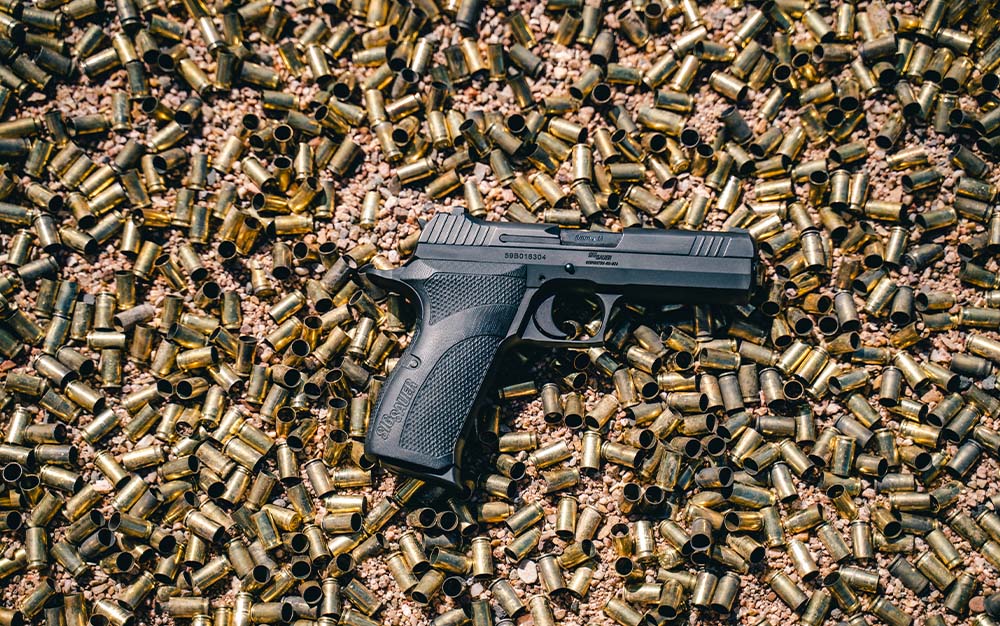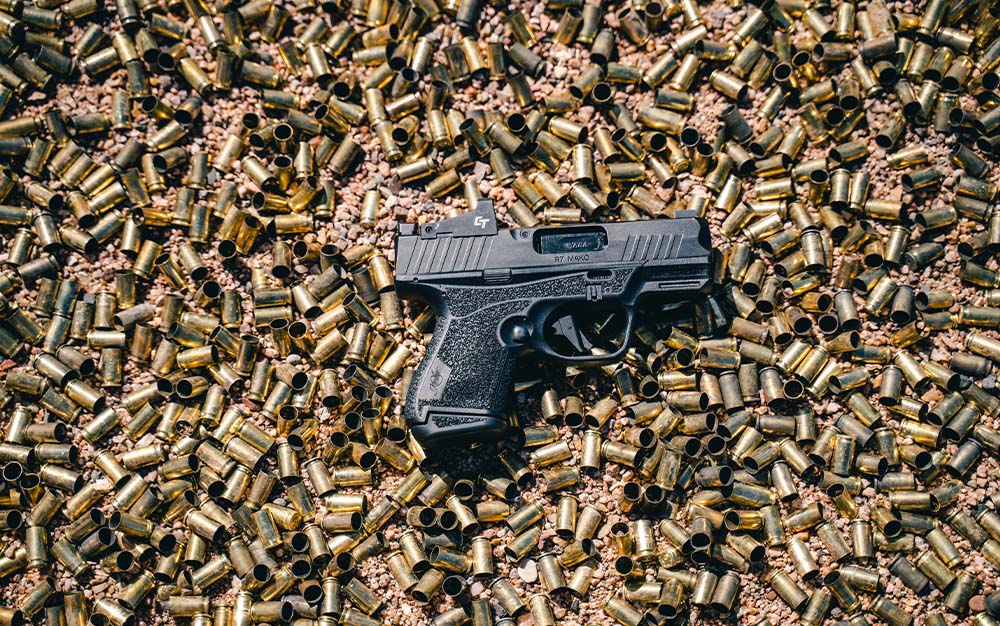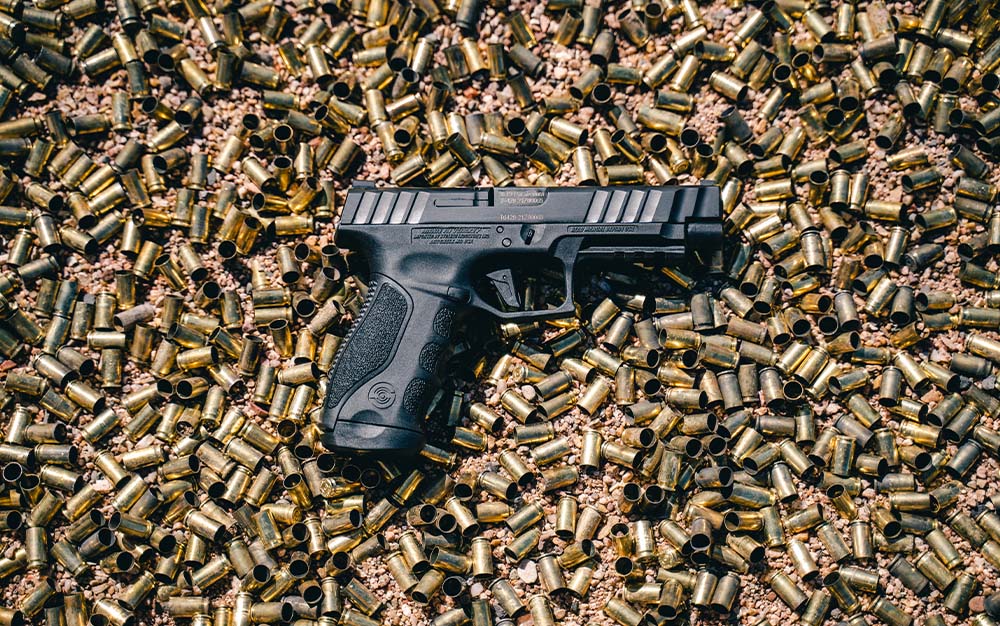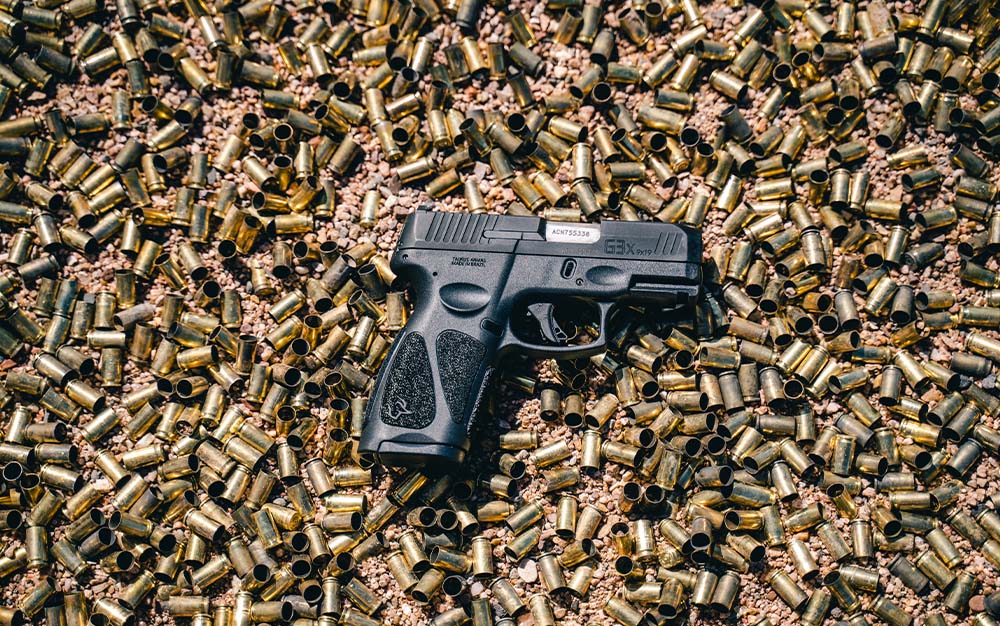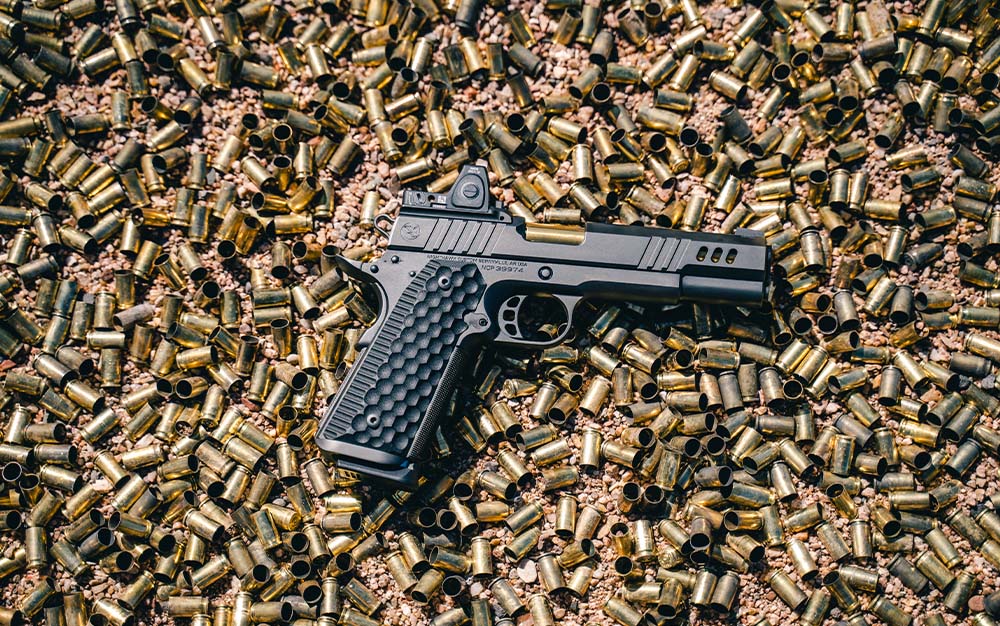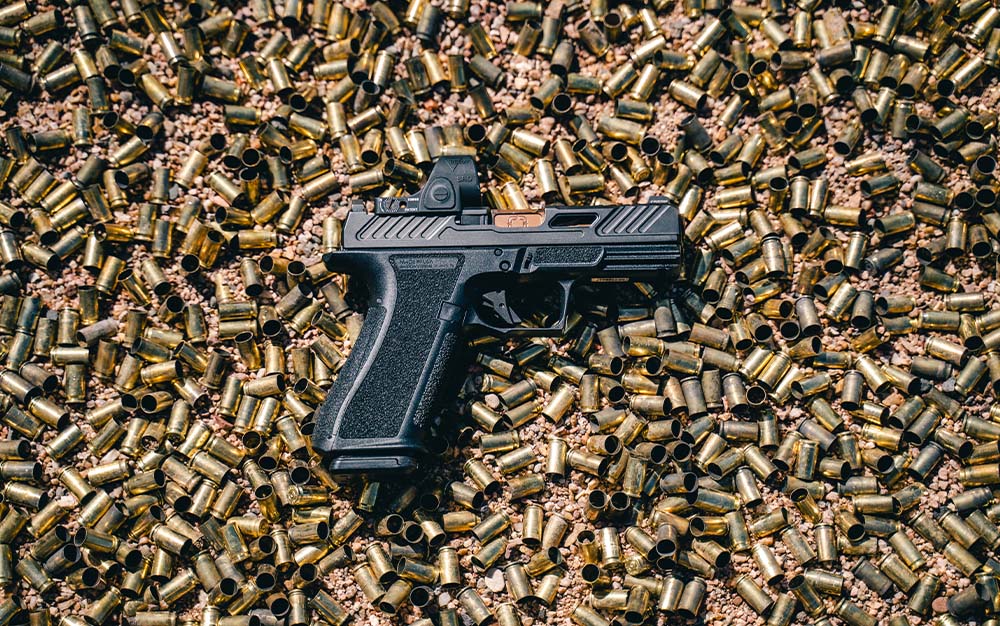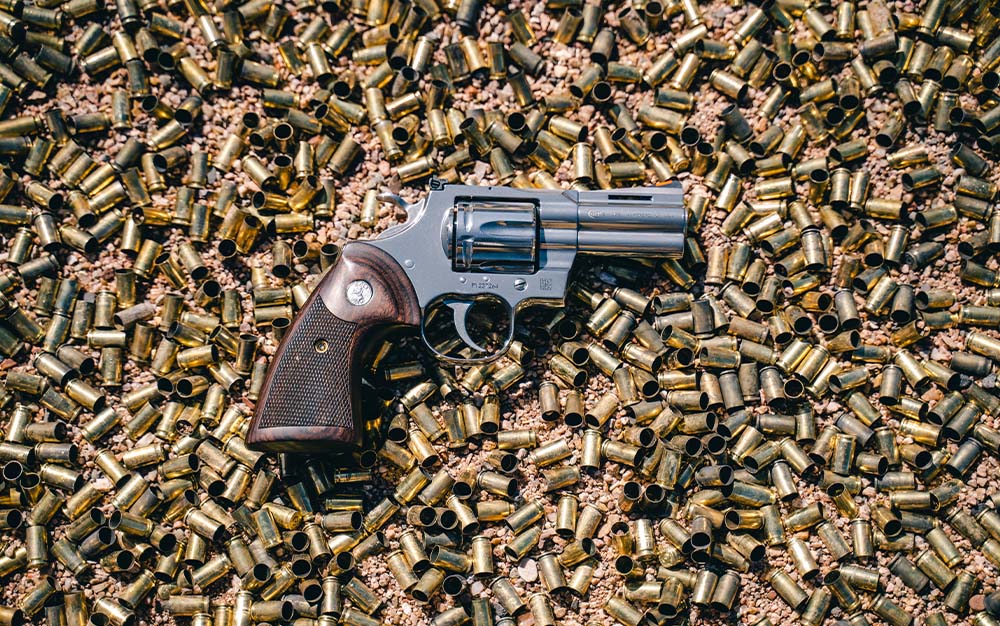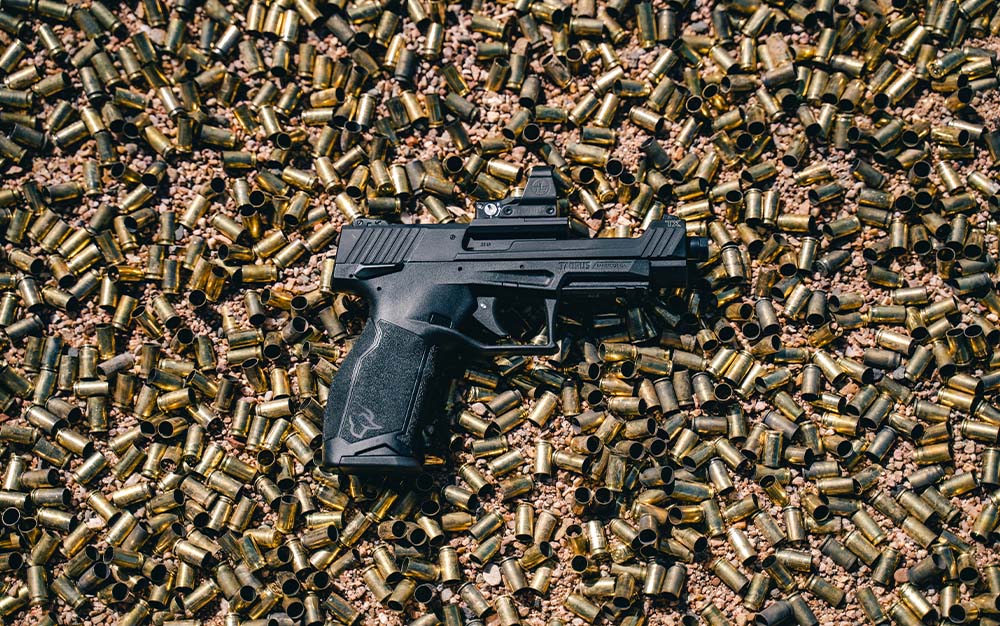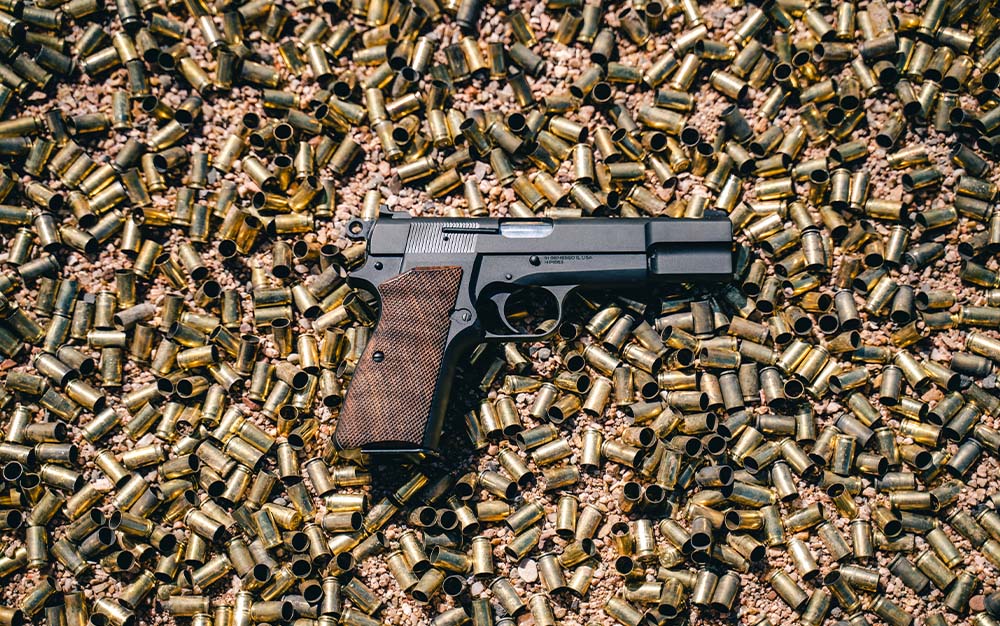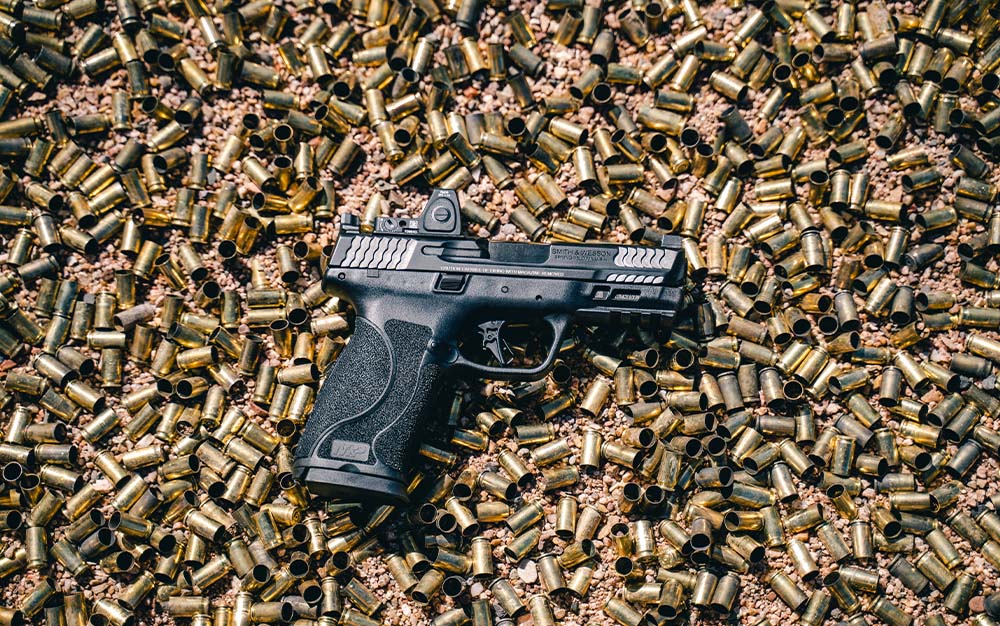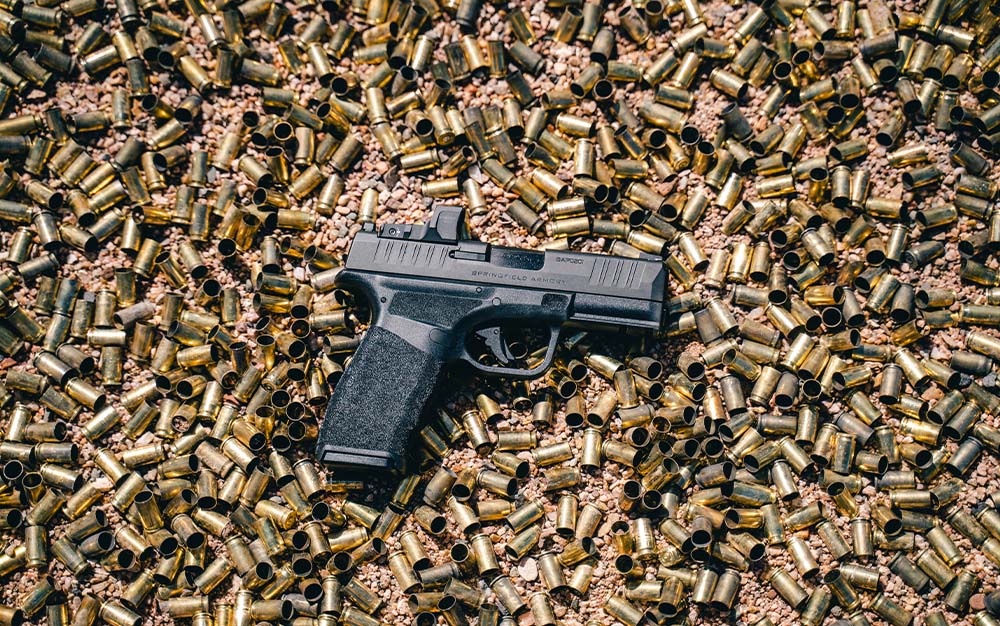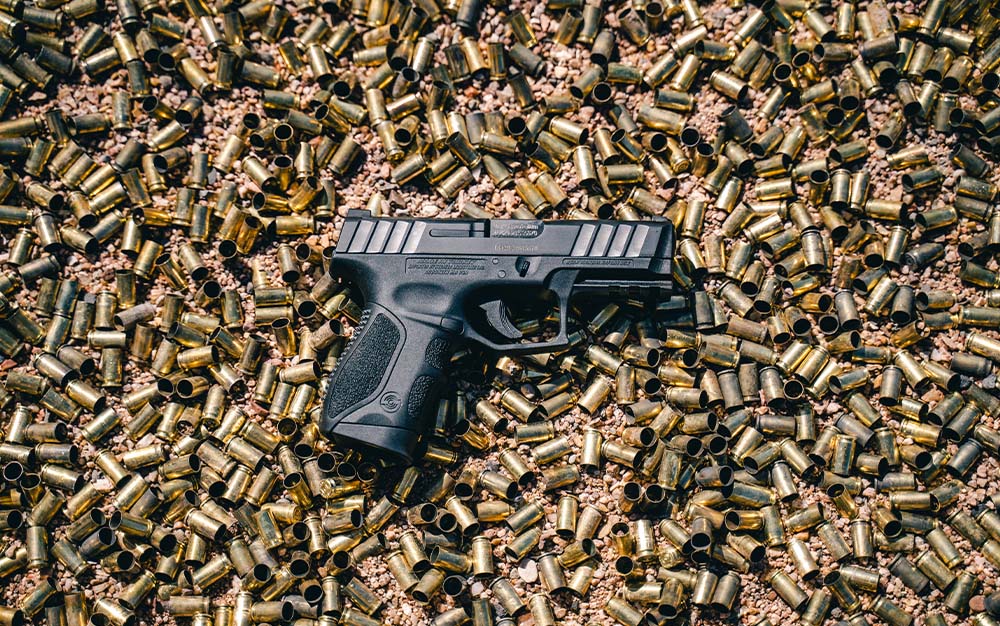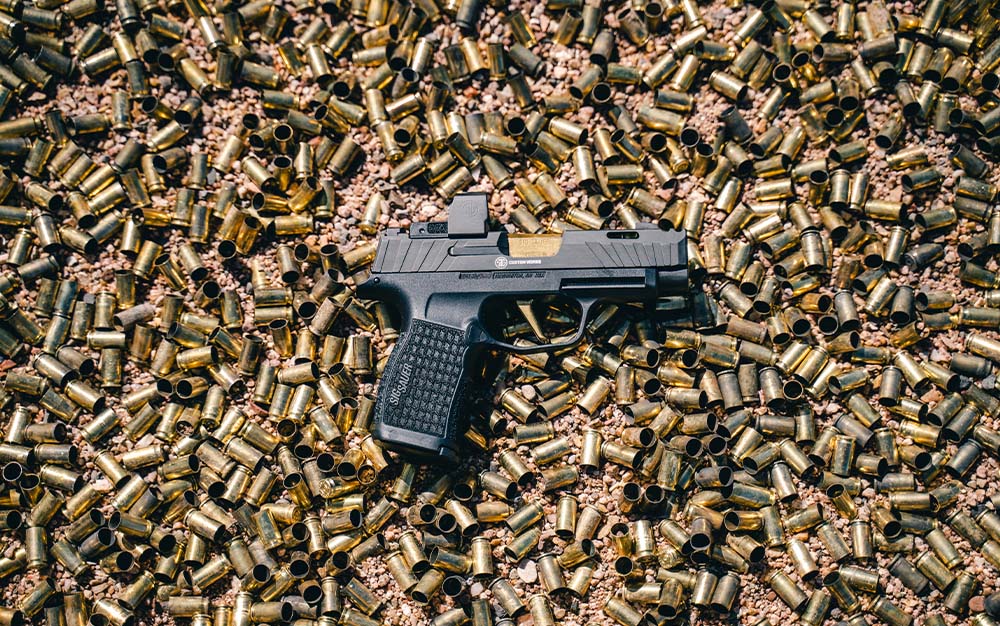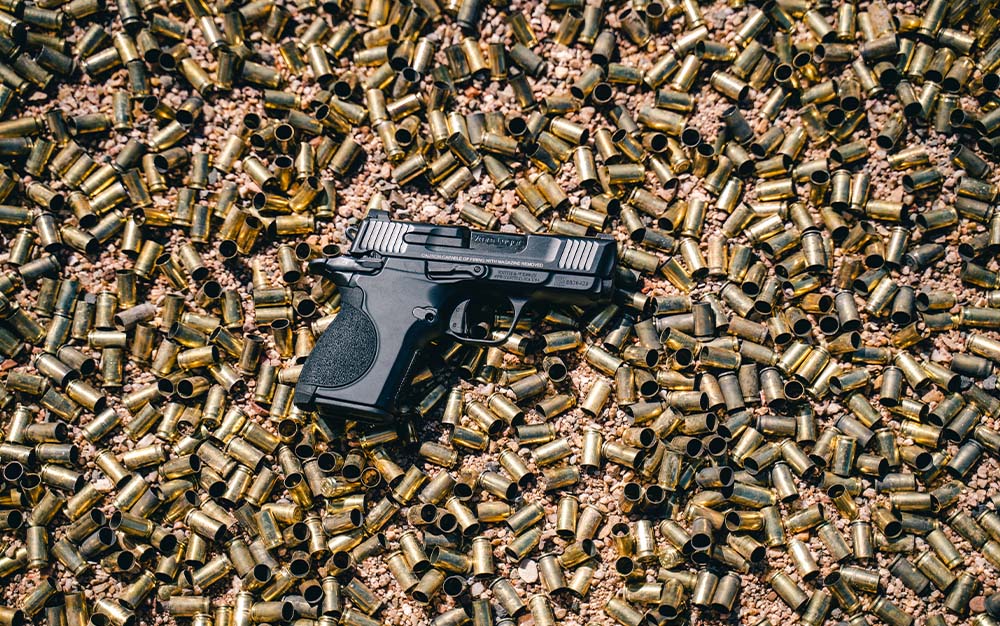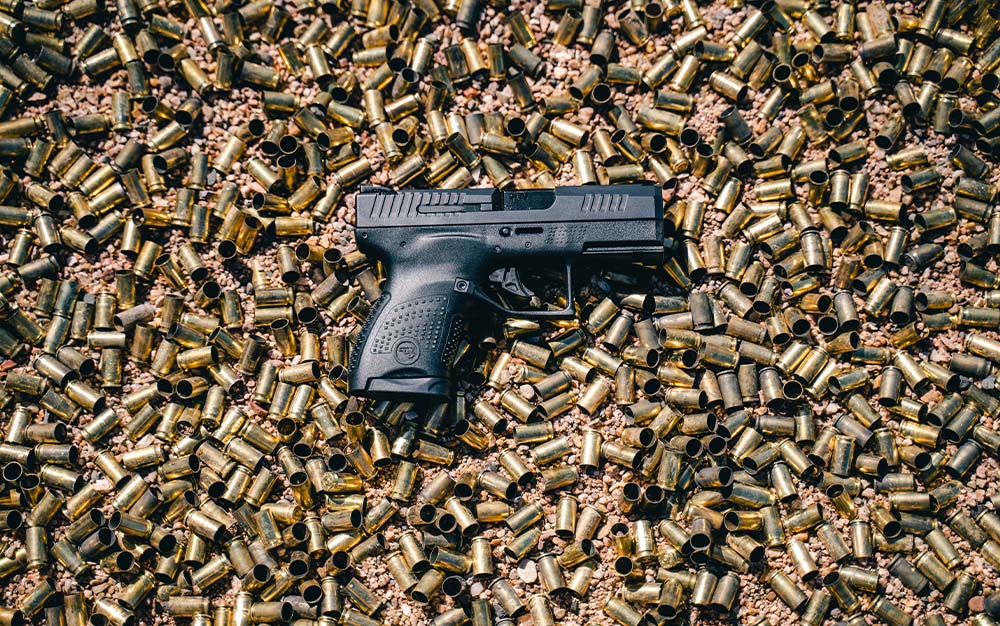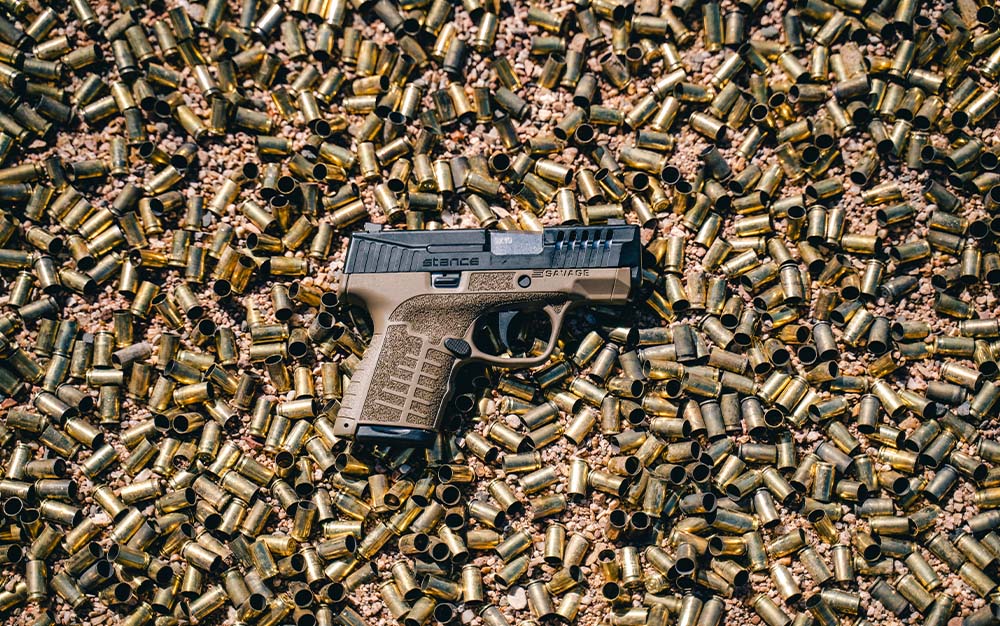We may earn revenue from the products available on this page and participate in affiliate programs. Learn More ›
The Handgun Test Award Winners
Best Handguns of 2022: A Cutthroat Field
How We Test
How We Grade
With this pistol, CZ did all the custom work to create a competition-ready handgun so you don’t have to. Out of the box it is configured for IPSC Standard division or USPSA Limited division matches. It comes with oversized controls and a pile of upgrades that help the pistol do what it does best—put lots of lead accurately on target in a short amount of time.
Of all the pistols in this year’s gun test we probably put the most rounds through the TS2. It comes with three 20-round magazines—in a nicely executed hard-sized case we might add—and we did all we could to load them up and empty them as quickly as possible.
A glance at the left side of the pistol’s frame shows the add-ons CZ included to enhance performance. The safety has an oversized tab that can serve as a shelf for the shooter’s thumb. The magazine release is raised and oversized for easy access and manipulation. It’s tipped with a nicely checkered tab done in the same vibrant green as the pistol’s stocks and the baseplates on the magazines.
A substantial thumb rest has been secured to the frame with two Torx fasteners. This shelf allows the shooter to put downward pressure on the pistol with the thumb of the support hand to minimize muzzle flip under recoil. The slide stop has a raised surface with three pronounced steps for easy manipulation as well.
When you add in the adjustable target sights, the crisp single-action trigger, the overall heft of the pistol (it tips the scales at a beefy 49 ounces) you end up with a gun that shoots, “almost on autopilot,” as one of our judges put it.
In fact, the only critique I can offer falls under the category of sour grapes. That is that it is optimized for right-handed shooters. Lefties, such as myself, need not apply. I still had a blast running the gun but was a bit jealous of my colleagues who could take full advantage of the TS2 Racing Green’s configuration. You can check out Tyler Freel’s glowing review of the CZ TS 2 Racing Green here.
Given how refined the pistol is, and what you get for the price—you can find it for less than $2,000 online—it isn’t surprising that it ran away with the Editor’s Choice award. For handling, accuracy, workmanship, ergonomics and reliability it garnered extremely high scores. It isn’t a particularly versatile pistol, but for competition and for general hobbiest range use it has few equals. —John B. Snow
READ NEXT: The Best 9mm Ammo
Editor’s Choice: Best Mid-Sized Handgun, Sig Sauer P210 Carry
Report Card
- Performance: Very Good
- Design: Very Good
- Value: Good
Sig Sauer P210 Carry Specs
- Caliber: 9mm Luger
- Magazine capacity: 8+1
- Dimensions: 7.75 inches (L), 5.63 inches (H), 1.44 inches (W)
- Weight: 29 ounces
- Frame: Aluminum, Nitron finish
- Slide: Stainless Steel with Nitron finish
- Barrel: 4.1-inch carbon steel
- Sights: Three-dot SigLite night sights
- Trigger: 4 pounds, 6 ounces (tested)
- Safety: Thumb
The new Sig Sauer P210 Carry is the latest iteration of one of the most revered and iconic defensive handguns ever made. The biggest changes to the platform include switching the frame material from steel to aluminum and shortening the barrel to 4.1 inches, which puts the overall weight of the P210 at a reasonable 29 ounces.
To further enhance the pistol’s appeal for defensive carry, Sig stocked it with well-executed G10 grips that are machined with a scalloped checkering pattern that give the pistol a secure hold and allow for easy access to the magazine release and safety.
The matte-black grips pair well with the Nitron finish that Sig used on the frame and slide. Coupled with the stout defensive sights—a square notch fixed rear and front post with illuminated dots—there’s no doubt as to the P210’s intended role.
That said, it is a much more refined pistol than your run-of-the mill striker-fired polymer wonder gun. It has a lovely crisp single-action trigger and the most aesthetically appealing safety and slide lock you’ll find on any defensive handgun.
Some shooters might be put off by the P210’s single-stack magazine that only holds eight rounds, but that didn’t bother us in the least. The pistol’s accuracy, speed on target, and overall shootability won us over. If you want an in-depth look at the evolution of the P210 and the P210 Carry, check out Sean Murphy’s Sig Sauer P210 review.
One drawback that does limit the P210’s versatility is that it is configured for right-handed shooters. There’s no way to reverse any of the controls and manipulating them as a lefty is a chore.
Despite this, the P210 rose to the top of the heap in the mid-sized pistol category earning an Editor’s Choice award. Combining elegance, utility and a good price it is a defensive carry gun with heirloom appeal. —JBS
Editor’s Choice and Great Buy, Micro-Sized Handgun: Kimber R7 Mako
Report Card
- Performance: Good
- Design: Good
- Value: Good
Kimber R7 Mako Specs
- Caliber: 9mm
- Capacity: 11+1 (flush), 13+1 (extended)
- Dimensions: 6.2 inches (L), 4.3 inches (H), 1 inches (W)
- Weight: 23 ounces. (with included optic, empty extended magazine)
- Frame: Glass-filled nylon grip and stainless-steel central block
- Slide: Stainless steel with FNC finish
- Barrel: 3.37-inch with 1:10 LH twist
- Sights: Tritium Pro Night Sights with orange front ring and dual white rear dots.
- Optic: Crimson Trace CTS-1500 reflex sight
- Trigger: 4 pounds, 4 ounces
There’s no shortage of micro-compact, striker-fired, optics-ready, 9mms out there, so we didn’t know what to expect when Kimber jumped into this competitive field with the R7 Mako. On the one hand, Kimber has built their reputation on creating feature-rich 1911s that offer shooters the custom touches they crave. On the other, it can be difficult and painful for gun makers to try to break into new markets, especially those that are saturated with established players.
But Kimber hit it out of the park with the R7 Mako and so impressed the judges that it earned an impressive, and uncommon, double win as both the Editor’s Choice and Great Buy in the micro-sized handgun category.
For a micro, the Kimber R7 Mako is remarkably easy to shoot. The smart texturing on the frame, the palm swell and dimensions of the grip, and the mass in the slide make the Mako a comfortable and accurate shooter.
The trigger is good for this class of pistol, breaking at 5-pounds 3-ounces. It has a sharp reset that was easy to find and was part of the reason the Mako did well during rapid-fire drills.
The pistol comes with two magazines, one that holds 11 rounds and sits nearly flush with the frame, and another that holds 13 rounds and extends below the grip far enough so that the shooter’s pinkie can grip the gun as well. That ¼-inch difference in length makes a huge difference in the shootability of the pistol, and if you have the choice you’ll definitely want to run that magazine as the primary.
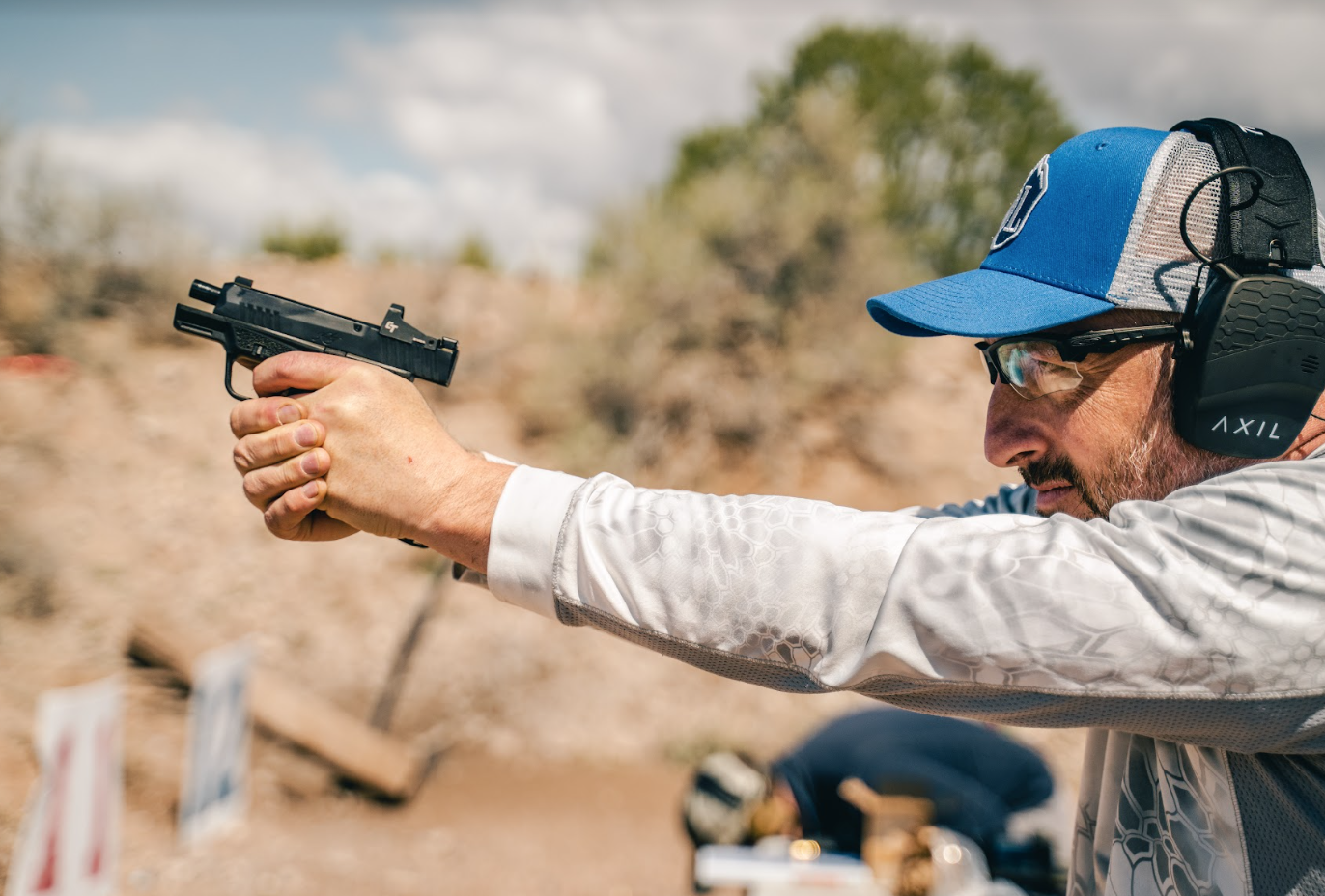
Speaking of the magazine, we were impressed with their construction, how easy they are to load to capacity and with how they dropped free from the pistol and clicked into place with smooth assurance.
The Kimber R7 Mako comes in two versions, one with an included red-dot, and the other with an optics-ready slide. Ours came equipped with a Crimson Trace CTS-1500. The price difference between the two models is $200, and if you’re at all mechanically inclined you can purchase a CTS-1500 for about $140 and save yourself a few bucks for some extra ammo.
But even with the optic included, we felt the pistol was a hell of a value. And given how well it ran out-of-the box while being smartly configured for concealed-carry use, it earned the Great Buy designation as well.
In this review of the Kimber R7 Mako, I did a deep dive on the gun prior to our test that goes into more detail. But the main takeaway is that even when shot against some stiff competition this new gun excelled. It never failed to function and digested everything we put through it. That reliability, combined with its refinements and smart design is what makes it a winner. —JBS
Great Buy, Full-Sized Handgun: Stoeger STR9-F
Report Card
- Performance: Good
- Design: Good
- Value: Excellent
Stoeger STR9-F Specs
- Caliber: 9mm
- Capacity: 17+1
- Dimensions: 7.95 inches (L), 5.6 inches (H), 1.22 inches (W)
- Weight: 26 ounces
- Frame: Polymer, matte black
- Slide: Cold-hammered alloy steel
- Barrel: 4.68-inch cold-hammered alloy steel
- Sights: Dovetail-fit 3-dot, white
- Trigger: 5 pounds, 3 ounces
If there’s one thing we appreciate at Outdoor Life, it’s a great value, and the Stoeger STR9-F is just that. At half the price of many similar striker-fired pistols, the STR9-F exceeded the expectations of the entire test team. It can be difficult to stand out in the market of polymer pistols, but the STR9-F turned heads.
Budget pistols can get a bad rap for fit, finish, and ergonomics, but those are areas that the STR9-F did well in. Although the workmanship and aesthetics of the pistol averaged fair to good among the test team, we found the handling and ergonomics to be good to very good.
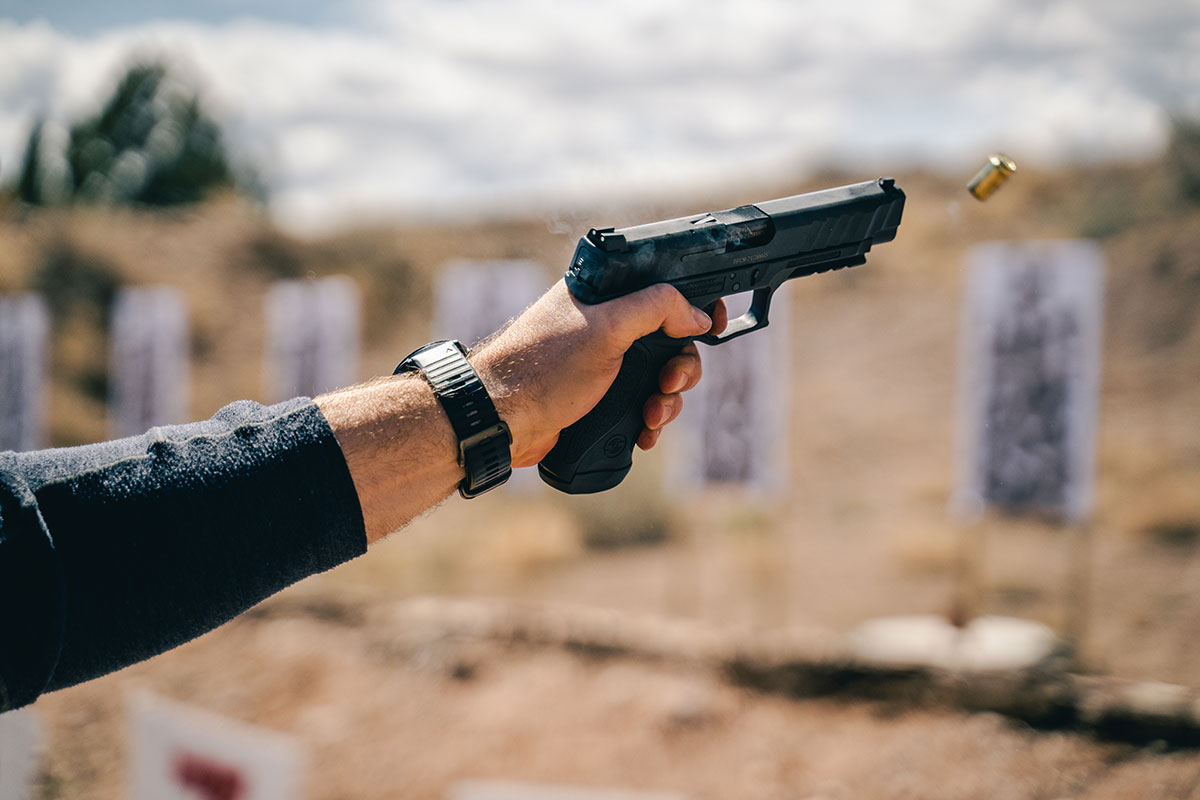
The Stoeger STR9-F is built with some similarities to both Glock and Smith & Wesson M&P pistols. It’s simple, but with a comfortable grip and good stippling texture. Some shooters found of the shape and contour of the grip to be easy to handle—and even preferable to some other stock grips.
The Frame of the STR9-F features a 3-slot accessory rail, and the rounded slide has aggressive front and rear cocking serrations. Simple white 3-dot sights top it off.
The biggest questions that the team—or any potential customer—might have in-regards to any handgun have everything to do with how easy a pistol is to shoot and how reliable is it? This is especially true if you’re trying to get the most bang for your buck. For any kind of practical-use handgun, affordability only matters if reliability comes with it. (Read the full review of the Stoeger STR9-F here).
While testing, the STR9-F functioned flawlessly with a wide variety of ammunition, from Federal Premium 115-grain range ammo to Hornady 124-grain and Nosler 147-grain defensive loads. The team like the grip angle and soft recoil cycle—one team member compared shooting it to the smooth-shooting Glock G34.
You won’t get fancy packaging or any extra magazines with the STR9-F, but what you are getting is a great value. It’s a simple, reliable pistol that looks good and is a sweetheart to shoot. For three hundred bucks, it’s eye-popping. There wasn’t even a close second for our Great Buy award in the full-size category. -Tyler Freel
Great Buy, Mid-Sized Handgun: Taurus G3X
Report Card
- Performance: Very Good
- Design: Good
- Value: Excellent
Taurus G3X Specs
- Caliber: 9mm
- Capacity: 15+1
- Dimensions: 6.3 inches (L), 5.2 inches (H), 1.2 inches (W)
- Weight: 22.6 ounces
- Frame: Polymer, matte black
- Slide: alloy steel
- Barrel: 3.2-inch stainless-steel
- Sights: Fixed front, serrated, drift-adjustable rear
- Trigger: 5 pounds, 8 ounces
In such a star-studded field of handguns to test, a striker-fired polymer pistol like the Taurus G3X with a budget-friendly price tag faces an uphill climb. Higher-profile guns tend to draw the affectionate attention of testers, and the more-affordable guns draw an even more scrupulous examination from the test team—searching for something not to like.
Outdoor Life readers appreciate value in guns and gear—and don’t appreciate being gipped or bamboozled. We search hard for true value and performance, and sometimes a product (handgun in this case) truly stands out as a fantastic value—which means not only is it easy on the pocketbook, but it brings the goods.
There likely wasn’t a handgun in the 2022 Gun test that exceeded expectations as much as the Taurus G3X. This compact 9mm is a typical striker-fired poly pistol on the surface, but when being shot, it thoroughly impressed the test team. (Read the full review of the Taurus G3X here).
The G3X is heavily influenced by the design of the Glock 19—which sets the standard for compact 9mm pistols (read Best Glocks for more info)—but it also distinguishes itself in ways that the G19 doesn’t. For one, it has the same capacity as a G19, but sports a shorter 3.2-inch barrel—a barrel length that’s closer to micro 9mm territory. This gives it a slight edge for some methods of concealed carry—especially appendix carry.
The Taurus G3X also features re-strike capability with its single-action trigger. This means that if you pull the trigger and the round fails to fire, you can pull the trigger again and it will re-engage the striker, hitting the primer again.
The grip of the G3X was very comfortable to handle and shoot, and it uses the increasingly-popular fine stipple texture that is a world apart from polymer pistol grips of just a few years past. It’s not abrasive, but gives the shooter ultra-secure traction.
Several members of the test team noted the good quality of the steel 15-round magazines that the pistol comes with. A bum magazine can ruin a perfect pistol’s reliability, and we were very happy with those that came with the Taurus.
Reliability is paramount for any concealed-carry pistol, but especially for a budget gun. The slightest hiccup plants doubts that are hard to overcome and are an instant turn-off. The whole test team was pleased with how well the G3X devoured every type of ammo we could throw at it—at an almost non-stop pace. With only some CLP on the slide rails and barrel, it handled everything we could run through it beautifully.
At less than $350, the G3X was a hands-down winner for our Great Buy award for compact pistols. Through copious amounts of ammunition, it held right with pistols that were twice the price—or more. -TF
Report Card
- Performance: Excellent
- Design: Very Good
- Value: Good
Nighthawk Custom President Specs
- Caliber: .30 Super Carry
- Capacity: 12+1
- Dimensions: 5.75 inches (H), 8.58 inches (L), 1.25 inches (W)
- Weight: 41.85 ounces
- Frame: Forged steel, government-size
- Finish: DLC coating
- Barrel: 5-inch match grade, bull profile, titanium nitride coating
- Sights: Trijicon RMR, 14k gold front dot
- Trigger: 3 pounds, 6 ounces
When it comes to top-end, multi-thousand-dollar pistols, perfection is the standard. Because of that, our test team eyed the Nighthawk Custom President with more scrutiny than just about any other handgun in the test. Value is important to us, and we want to make sure you’re getting an exceptional product for all that coin. At the end of testing, we were pleased to find that the President delivered.
Chambered in the new .30 Super Carry from Federal Premium, the President is a highly-refined single-stack 1911. It comes with a DLC-coated slide and frame, and the slide has front and rear cocking serrations, as well as weight-reducing cuts that show off the gold-colored titanium nitride finish on the barrel.
The President we received came in a deluxe padded case and was topped with a Trijicon RMR red dot sight with a co-witnessable 14-karat gold front bead sight. The grip is excellent, with fine checkering on the front and back straps, a long beavertail, and large-pocked Railscale grip scales.
Workmanship on the Nighthawk Custom President is wonderfully tight, exemplified by things like the finely-checkered recoil spring plug and muzzle crown that is recessed from flush with the barrel bushing. (Read the full review of the Nighthawk Custom President here).
Looks would all be for naught if the gun didn’t shoot, but it shot as smooth as it looked. The President is heavy—nearly 42 ounces—and that means recoil mitigation. The team felt that the .30 Super Carry loads we fired through the President recoiled about like a 9mm—something the cartridge is designed to ballistically emulate at a smaller diameter. In a heavy, finely finished pistol like the President, that means smooth and fast.
As expected for the price tag, the President functioned flawlessly, and was a dream to shoot. I was able to clean double-spinner targets quickly with little trouble. Although it’s one of a handful of initial .30 Super Carry offerings, we feel that it isn’t really the type of pistol that takes advantage of the cartridge’s attributes. However, we can’t say anything negative about the pistol or its performance. It was one of the best handguns in our test. Although it’s an expensive, niche pistol, we can see what you’re getting for the money. -TF
Report Card
- Performance: Very Good
- Design: Very Good
- Value: Very Good
Shadow Systems XR920 Specs
- Caliber: 9mm
- Capacity: 17+1
- Action: Striker fire
- Barrel: 4 inches
- Dimensions: 7.25 inches (L), 5.25 inches (H), 1.2 inches (W)
- Weight: 21 ounces
- Trigger: 5 pounds, 10 ounces
- Sights: Fixed, front green outline Tritium Dot, rear black serrated
The Shadow Systems XR920 is built for the shooter who wants a concealable pistol that doesn’t sacrifice a single round of magazine capacity. To accomplish this, the XR920 mounts a compact slide on a frame that accommodates 17+1 sized Glock-style magazines.
But as with all of Shadow Systems’ offerings, the XR920 wasn’t created with a purely utilitarian end in mind. It follows the formula for success that this young gun company has built their reputation upon. They take the world’s most popular handgun platform—the Glock—and add all the cool things that a shooter could wish for while keeping the price of the product reasonable.
With the XR920 Elite what you get is an optics-ready slide that’s been machined with a cyberpunk aesthetic with weight-reducing cuts and cocking serrations on the slide’s rear, front, and top.
The barrel comes with good-looking spiral flutes and can be had threaded if you want.
The frame also has several upgrades that separate it from Glock pistols it is based on. The grip has panels with nicely done stippling on the front, rear, and sides. There are also pads of stippling on the frame for the support-hand thumb. The trigger guard has been thinned out and sculpted. The frame also incorporates a pronounced beavertail on the grip for better control.
Other useful elements include a flared magazine well and accessory rail.
Our sample weighed just 21 ounces, making it a comfortable option for all-day carry and nearly as light as some micro 9s. Thanks to its ergonomic enhancements, the pistol shoots well. The judges gave it high marks for accuracy, handling, and reliability. (We had zero issues with the pistol during the evaluation.) We mounted a Trijicon SRO on the pistol and were able to get fast hits on paper and steel.
The trigger on the XR920 is just so-so and was the one element we’d upgrade. Our sample broke at 5 pounds 10 ounces and exhibited the heavy take-up typical of stock Glocks.
That’s an easy DIY fix, however.
Other features we liked included the interchangeable back-straps to customize the grip dimensions and the included iron sights, which incorporate a high-visibility front post with a tritium insert outlined in bright green. —JBS
Report Card
- Performance: Very Good
- Design: Very Good
- Value: Very Good
Colt Python 3-inch Specs
- Caliber: .357 Magnum
- Capacity: 6 rounds
- Barrel: 3 inches, 1:14 LH twist, 6-groove
- Dimensions: 8.5 inches (L), 5.5 inches (H), 1.55 inches (W)
- Frame: Stainless Steel
- Finish: Semi-bright
- Grip: Walnut
- Sights: Adjustable (windage and elevation) rear, interchangeable orange ramp front
- Action: Double action/Single action
- Trigger Pull (single action): 5 lb. 7 oz. (measured)
- Weight: 2 pounds, 6 ounces
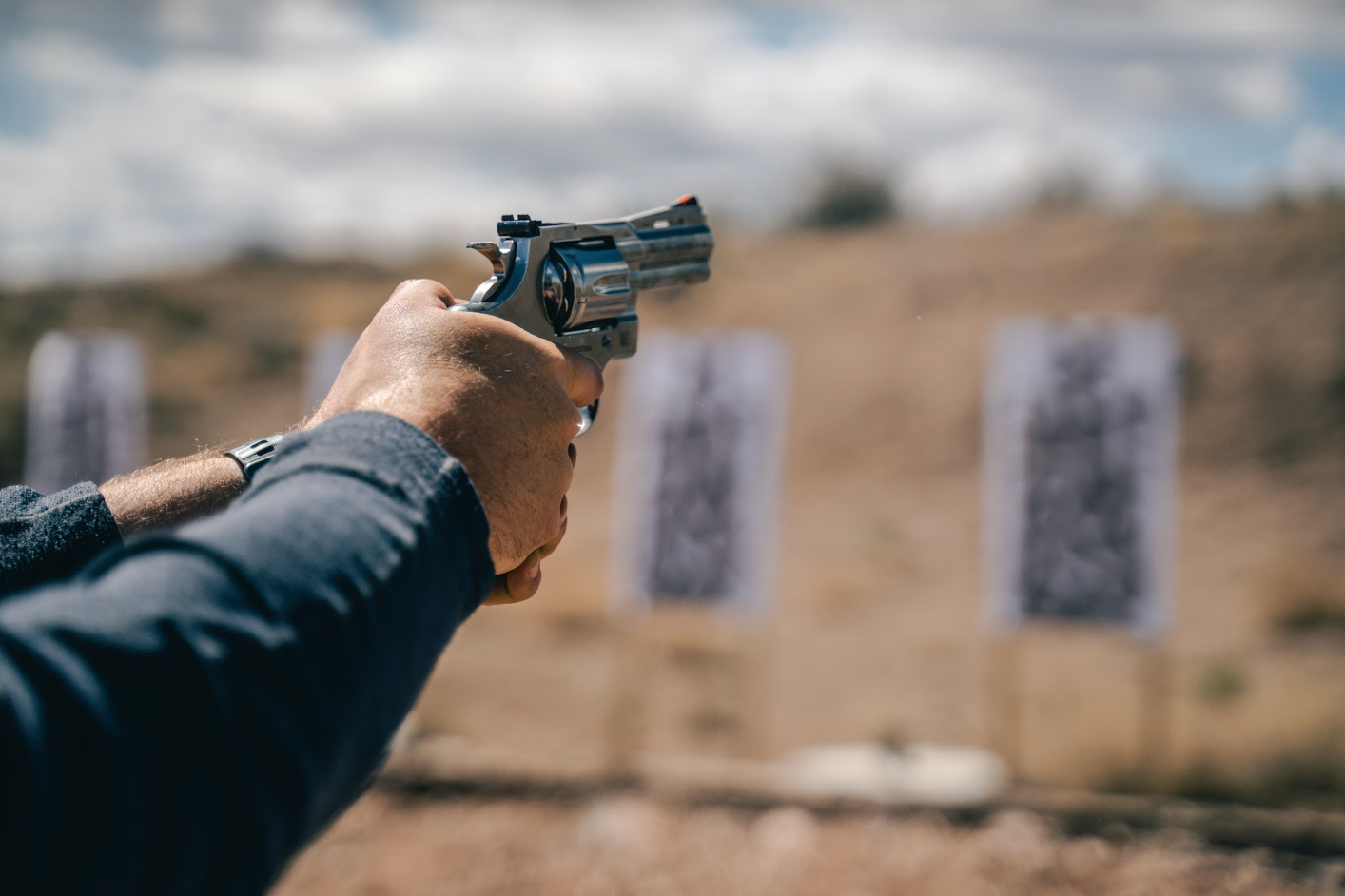
Classic line re-introductions often generate discourse that would make post-election Thanksgiving dinners seem docile, and Colt’s reintroduction of the Python is no exception. This year, Cold expanded that re-launch with a 3-inch barreled model of their legendary Python in .357 Magnum.
Colt’s claim with the new Pythons—including the 3-inch model—is to bring the same level of quality and craftsmanship that the original Pythons were known for. They even set out to improve the strength of the frame by adding some steel under the adjustable rear sight. A die-hard original Python fan might squawk about them not being as good as the original, but we found our test sample to be superb. (Read the full review of the Colt Python 3-inch here).
The Python 3-inch is a piece to look at, and the walnut grips possess an almost intrinsic warmth. The six-shooter scored very high among the test team in aesthetics, handling, ergonomics, and reliability—averaging very good to excellent scores for each category.
Even after running the Python hard, the cylinder spun like butter, and locked up smoothly with no slop. The fit and finish was excellent, and even the seam between the crane and frame almost disappears when the cylinder is closed.
The 3-inch Python isn’t the most versatile of the snake series, and certainly not as accurate as the longer-barreled models. These are the only areas of evaluation that the Python averaged less than “very good” scores. The barrel is just long enough to have that signature Python look and a single vent in the rib running along the top of the barrel. It features an adjustable rear sight and an interchangeable orange-ramp front post if you need to make major changes to your elevation.
We shot the hell out of the Python and enjoyed every minute. At 7 yards, .38 Special loads were a breeze to keep on-target, and we could run full-power Hornady .357 Mag defensive loads quickly and accurately. If we had speed loaders on the range, we may well have melted the thing. -TF
Report Card
- Performance: Very Good
- Design: Very Good
- Value: Very Good
Taurus TX22 Competition Specs
- Caliber: .22 LR
- Capacity: 16
- Action: Single-action, striker fired
- Barrel: 5.25-inches, threaded
- Dimensions: 8.15 inches (L), 5.44 inches (H), 1.25 inches (W)
- Weight: 23.2 ounces
- Trigger: 5 pounds, 5 ounces
- Sights: Optics ready, fixed front, adjustable rear
Some guns are meant for serious work and some guns are meant for fun. The Taurus TX22 falls squarely in the latter category. Taurus tricked out this rimfire with an optics-ready slide, threaded barrel, adjustable iron sights, accessory rail, and a host of intelligent ergonomic touches.
For starters, the TX22 has a full-sized frame with a well-designed grip. Being a .22, it wouldn’t be difficult to control under any circumstances, but the deep cut in the grip under the rear of the slide forms a nice beavertail that allows the shooter’s hand to snug up to the pistol. The swell in the backstrap and the finger groves on the front of the grip make the TX22 as comfortable as a 70s-era El Dorado.
The TX22 comes with an excellent ambidextrous manual safety. It has a low profile but is easy to manipulate with either hand. Some higher-end pistols could take a page from its design.
The 16-round magazine is also very good. It approximates the dimensions of a double-stack 9mm magazine making it easy to hold and maneuver. It also loads easily. Even more importantly it feeds like a charm. Prior to the gun test, I put hundreds of rounds through this pistol and experienced only a couple failures to feed. During the week-long evaluation at Gunsite, none of the testers recorded any feeding, cycling or ejection issues. It earned one of the highest reliability scores of the test.
One nice design element is how the optics plate mounts directly to the barrel, which in turn locks up to the frame so that it doesn’t move under recoil. Consequently, keeping the red dot on the target is a snap, and contributes to the pistol’s fast and accurate shooting.
The TX22 takes down easily as well for hassle-free maintenance. The conveniently placed takedown tab, located on the underside of the frame in front of the trigger, is unobtrusive yet requires minimal effort to manipulate.
All-in-all, the TX22 Competition is a refined and eminently enjoyable pistol that packs a lot of smart features into its design and represents a good value for the money. —JBS
Report Card
- Performance: Very Good
- Design: Very Good
- Value: Very Good
Springfield SA-35 Specs
- Caliber: 9mm Luger
- Capacity: 15+1
- Dimensions: 7.8 inches (L), 4.8 inches (H), 1.25 inches (W)
- Weight: 32 ounces
- Frame: Forged carbon-steel, blued
- Slide: Forged carbon-steel, blued
- Barrel: 4.7-inch, cold hammer-forged, 1:10-inch twist
- Grips: Checkered Walnut
- Sights: White dot front, serrated “U-notch” rear (windage adjustable)
- Safety: Right-handed, thumb-select
- Trigger: 4 pounds, 10 ounces
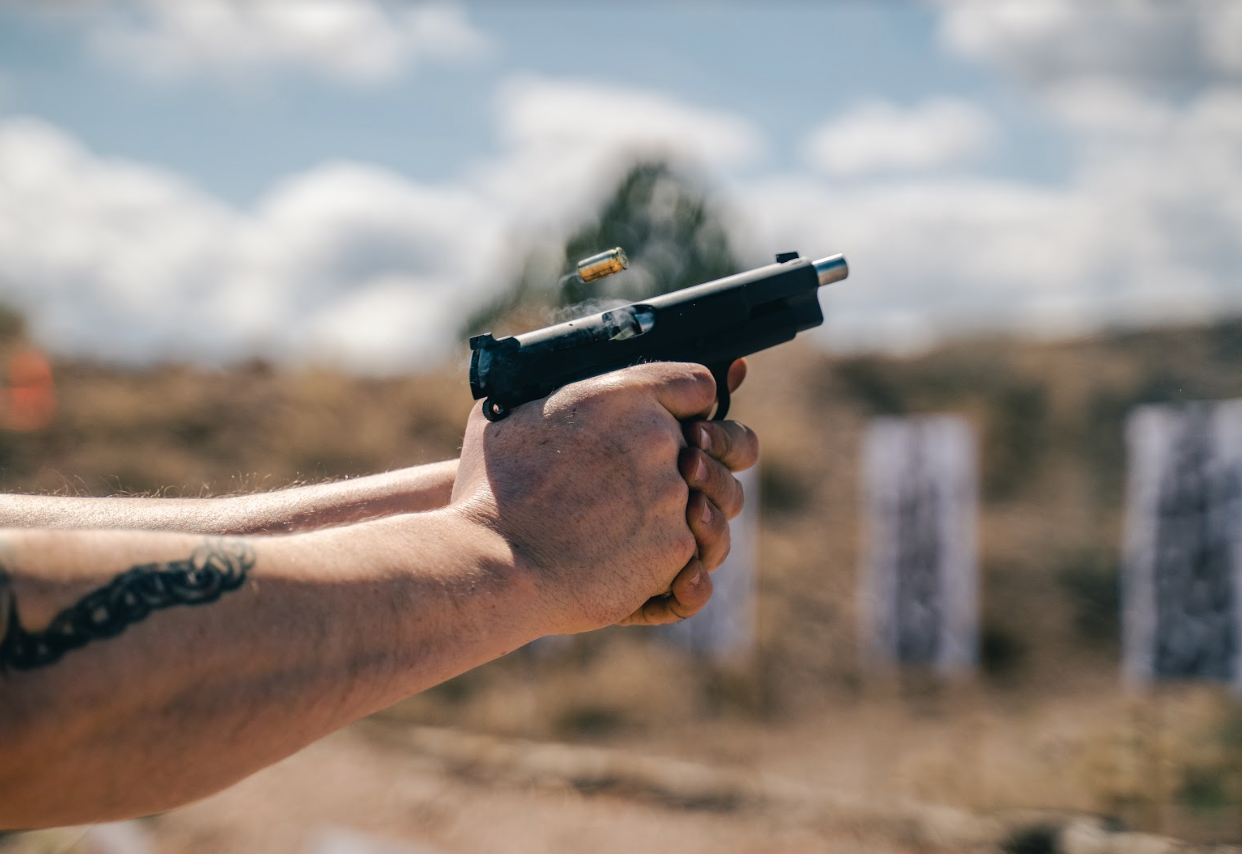
One of the most anticipated handguns of the year has been the Springfield Armory SA-35. This re-launch of one of the most popular and influential 9mm pistols of the 20th century—the Browning Hi Power, or P-35—might have been a big risk, but Springfield nailed it. Multiple clones exist on the market, but the Hi Power hasn’t even been out of production very long, and Springfield set out to put their personal touch on it.
The SA-35 is Springfield’s P-35, but with a few improvements—and at a better price than any good-quality Hi Power. It features a simple matte, almost parkerized-looking blued finish on its forged carbon steel frame and slide. The improvements of the design are subtle but make a big difference in the end-product, bringing it more in-line with modern defensive handguns.
First, the magazine disconnect has been eliminated. This means that unlike many previous iterations of the design, the pistol can fire without the magazine inserted. As a side-benefit, the elimination of the magazine disconnect greatly improves the trigger—and the SA-35 has an excellent one. (Read the full review of the Springfield Armory SA-35 here).
Second, the magazine capacity was increased to 15, compared to the original 13. The magazines still fit flush and function wonderfully.
Third, the hammer dimensions were changed slightly to decrease the propensity of the hammer to pinch (or bite) the web of the hand when the slide travels all the way to the rear after the pistol is fired.
The right-handed safety lever is winged out slightly for more positive operation, and as in previous designs—doubles as a takedown lever. Overall, you won’t find any surprises if you’re familiar with Hi Powers, but you’ll likely find these features to be pleasantly improved.
The SA-35 had all-around strong scores in every category and was a favorite among our test team, especially at the steel range. This is one of the best new handguns on the market for Hi Power fans looking for a new pistol. It’s soft-recoiling, and we didn’t experience any malfunctions while burning through several hundred rounds of ammo. The only negative observation was that the back corner of the beavertail could have used some rounding out. It’s a fairly sharp edge that tends to dig in with a high volume of shooting. -TF
Report Card
- Performance: Very Good
- Design: Very Good
- Value: Very Good
Smith & Wesson M&P 2.0 10mm Specs
- Caliber: 10mm Auto
- Capacity: 15+1
- Barrel: 4-inch, stainless steel, 1:10 5R
- Dimensions: 7.2 inches (L), 5.6 inches (H), 1.3 inches (W)
- Weight: 27.8 ounces
- Frame: Polymer
- Slide: Stainless steel with optics cut and adapter plates
- Finish: Black Armornite
- Grip: Interchangeable backstraps, abrasive texturing
- Sights: Steel, white 3-dot, optic-height
- Trigger: 4 pounds, 9 ounces
One especially hot category in the handgun market is the resurged 10mm Auto. A lot of this can be attributed to its contemporary acceptance as a bear defense cartridge. Although it’s not a true powerhouse, the 10mm—and pistols chambered in 10mm—have characteristics that make them very attractive to backcountry users.
The Glock G20 has been the standard striker-fired polymer 10mm for years, but some newcomers have been showing up, including Smith & Wesson. The M&P 2.0 10mm brings the ergonomics that so many people like in the M&P line—but with a little more punch.
The M&P 2.0 10mm features a 4-inch barrel and is built on the M&P 2.0 .45 ACP frame. It comes with two steel 15-round magazines, and several different handgun optics adapter plates. It’s nearly a quarter-pound lighter than a stock G20, and significantly more-streamlined with interchangeable grip backstraps and rounded slide.
A particularly notable feature on the M&P 2.0 10mm is the grip. It has interchangeable backstraps and features a fine-but-aggressive stippling texture. Recoil of the 10mm tends to be pretty peppy, and a grip that fits well in the hand—and one you can hang on to—is a huge benefit. (Read the full review of the Smith & Wesson M&P 2.0 10mm here).
The M&P 2.0 10mm has an accessory rail that can host a light and has ambidextrous slide stop levers and a reversible magazine catch button. Red dot mounting is a cinch via the included mounting plates, and the pistol comes with tall sights that are co-witnessable through many optics.
Being a 10mm, the test team didn’t find it quite as fun to shoot as many of the 9mms, but it still posted good scores for accuracy and handling, and very good scores for reliability and purpose. Compared to a G20 and Springfield Armory XDM Elite 3.8-inch 10mm, we found the lightweight M&P 2.0 to have snappier recoil, but the tradeoff is in weight and ease-of carry.
The 4-inch barrel is shorter of that than the G20, making it more convenient to carry, and while testing a wide variety of 10mm ammunition, I found that velocity losses on the 3.8-inch and 4-inch 10mm barrels average only about 100 fps compared to longer 5-inch barrels.
We like the Smith & Wesson M&P 2.0 10mm, and if you’re a fan of the M&P pistols, we think you will too. -TF
Report Card
- Performance: Very Good
- Design: Very Good
- Value: Good
Springfield Hellcat Pro Specs
- Caliber: 9mm
- Capacity: 15+1
- Action: Striker fired
- Barrel: 3.7-inches
- Dimensions: 6.6 inches (L), 4.8 inches (H), 1 inch (W)
- Weight: 20.7 ounces
- Trigger: 7 pounds, 8 ounces
- Sights: Fixed, Tritium/luminescent front, “U” Notch, white outlined rear
Like many of its peers, the Springfield Hellcat Pro seeks to strike a perfect balance between concealability and magazine capacity. In that regard, they did a good job. It is a hair smaller than a Glock 19 and a hair larger than the Micro-9s but has a 15+1 capacity with flush-mounted magazines. It is also trimmer than a G19 and has low-profile controls for snag-free carry.
Like other Springfield pistols, it is spec-ed out with a solid list of features. It has a revisable magazine catch, a loaded-chamber indicator on the top of the slide, it comes with two quality magazines, has a tough Melonite finish, a generously-sized accessory rail, and cocking serrations on the front and rear of the slide.
The Pro’s slide is also optics-ready, and our model came equipped with Springfield’s Hex Wasp reflex sight. Curiously, we preferred how the Hellcat Pro shot with the red dot removed. The fixed sights on the handgun consist of a semi-circle notch on the rear sight outlined in white and a big, bold illuminated circle on the front sight. It’s an excellent setup that allowed us to get on target quickly and place rounds into the vital zones.
As is common with reflex sights designed for concealed carry, the Hex Wasp has a fairly small window and under recoil we would lose the dot for half a beat longer than normal, which slowed us down and made us feel hesitant on the trigger. But with the sight removed, the pistol’s shooting qualities shone.
Managing the Hellcat Pro’s recoil is helped by the subtle contours machined into the grip and frame. The front strap has three shallow finger groves that fit all our hands nicely. The beavertail on the rear of the grip, while not overly deep, is pronounced enough to settle the axis of the bore close to the web of the shooting hand. And small concave pads on the front of the frame provide a good index spot for the support-hand thumb so that the shooter can apply pressure to counteract muzzle flip. Those pads have the same mild stippling that Springfield incorporated around the rest of the stock. Though not overly aggressive, the texture does help secure the pistol in the shooter’s hands.
We wished the trigger on our pistol were a bit lighter. At 7 ½ pounds it was a little distracting. But all-in-all we found the Hellcat Pro to be well made for its intended purpose and appreciated the pistol’s good ergonomics. —JBS
Report Card
- Performance: Good
- Design: Good
- Value: Very Good
Stoeger STR-9C Optics Ready Specs
- Caliber: 9mm
- Action: Striker Fired
- Capacity: 13+1
- Barrel: 3.8 inches
- Dimensions: 7.44 inches (L), 5.4 inches (H), 1.2 inches (W)
- Weight: 24 ounces
- Trigger: 6 pounds, 15 ounces
- Slide Finish: Nitride-hardened Matte Black.
- Sights: 3-dot fixed
We had a lot of good things to say about the Stoeger STR-9C, especially in view of its budget-friend price. It has an MSRP of just $399, and during the week-long test it held its own against much pricier competition. That alone was enough for us to develop a sweet spot for the pistol.
The fanciest thing about the STR-9C Optics Ready is that the slide is cut for mounting a reflex sight. That feature has become de rigueur on defensive pistols and is one of the reasons that this Stoeger should do well in the market.
Mechanically, the Stoeger is a Glock clone. It functions just like a G19, takes down the same way, and has virtually identical internal parts. The Stoeger does have more aggressive visual styling than a stock Glock, however. The cocking serrations on the slide are deep and bold and provide an excellent purchase for the shooter’s hands. And the checkering on the backstrap is sharp and aggressive—so much so that you might be tempted to hit it with some emery cloth to smooth it out a bit. The stippling on the sides and front of the grip are less abrasive, however.
We found the Stoeger to be a soft shooter, despite having a nearly 7-pound trigger weight. The trigger did have a positive reset that we liked, and that certainly contributed to how well we were able to run it during our drills.
While it doesn’t bring a lot to the party in terms of refinement or visual appeal, this is a solid defensive pistol that, with a bit of modification to the grip, would serve any shooter well. —JBS
Report Card
- Performance: Very Good
- Design: Good
- Value: Poor
Sig Sauer P365XL Spectre Comp Specs
- Caliber: 9mm
- Capacity: 12+1
- Action: Striker Fired
- Barrel: 3.1 inches
- Dimensions: 6.6 inches (L), 4.8 inches (H), 1.1 inches (W)
- Weight: 20.7 ounces
- Trigger: 7 pounds, 8 ounces
- Sights: Fixed 3-dot, illuminated
The Sig Sauer P365XL Spectre Comp is an undeniably cool pistol. Using Sig’s successful P365 platform as a starting point, the company’s Custom Works division added numerous features to create a best-in-class micro-compact 9mm.
Two of the more apparent upgrades are the Titanium Nitride gold barrel and trigger, and the optics-ready slide with its integral compensator. Sig claims the compensator reduces muzzle flip by nearly 30 percent. We weren’t able to verify that figure, but we did like how well the pistol shot, especially for its size.
That statement, “especially for its size,” is one the test team judges trotted out repeatedly while evaluating the Spectre Comp. We liked its trigger, which was notably good for a micro-compact. The in-hand feel of the gun and ability to shoot it comfortably and well was also excellent for a small pistol. The XRay3 Day/Night sights (as Sig calls them) are really good as well—again, especially for a gun of its size.
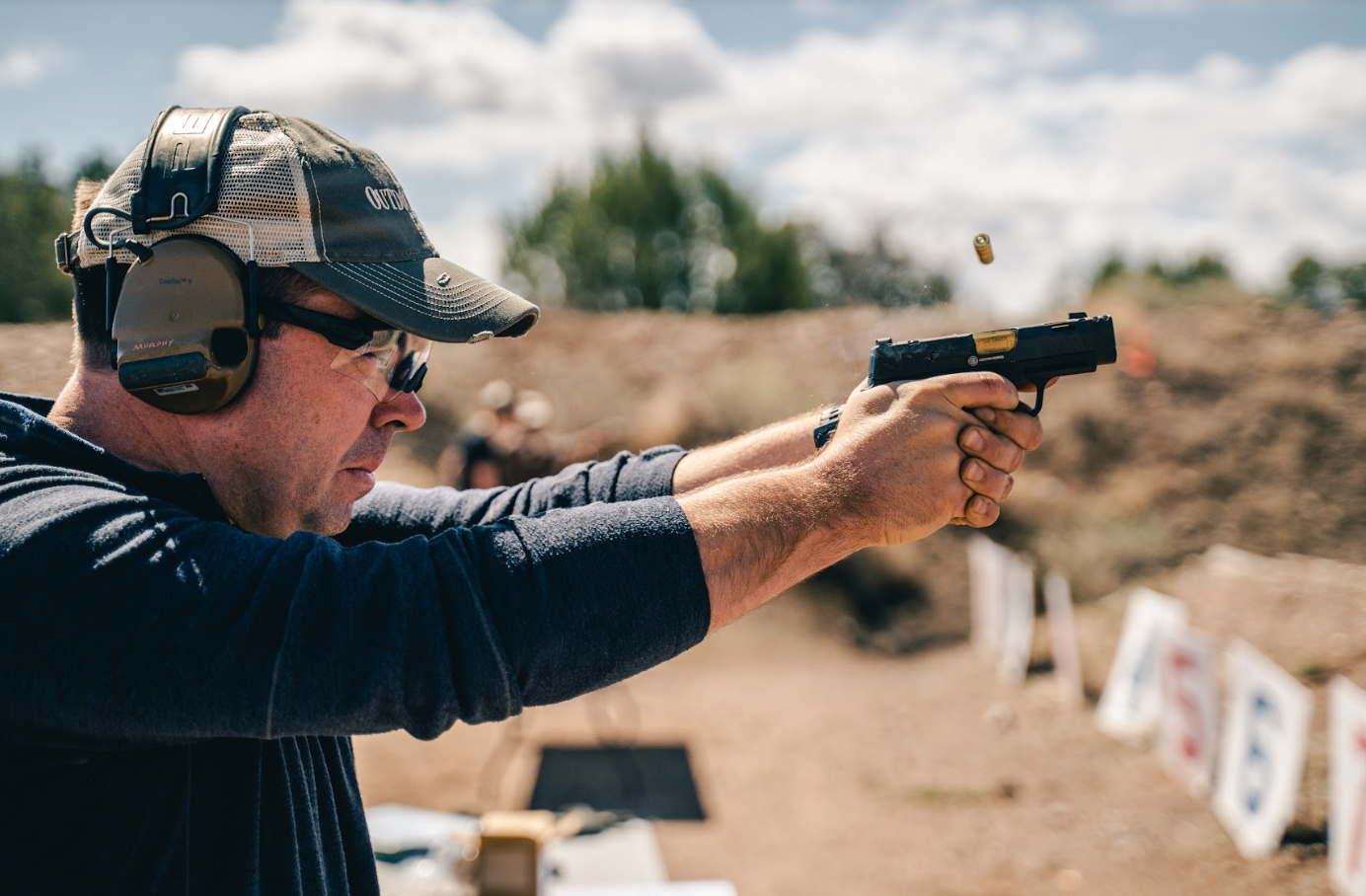
One of the cooler touches on the pistol is the integrated mag well. It’s a small detail, but one that enhances the ability to conduct confident reloads under stress. The laser-cut stippling is also very well executed. It offers enough purchase to control the gun well without being so aggressive that it might hang up on clothing.
The pistol comes with two 12-round magazines, offering a lot of firepower in a small package. Among the micro-compact pistols it was the most accurate of the test. It’s reliability also earned it high marks. It exhibited zero failures during the evaluation.
The only issue we had with the pistol is its price. Granted, it has a lot of upgrades and it comes with some extras that will appeal to the Sig faithful like the Custom Works challenge coin. But $1,299 seems pretty steep despite its refinements. The counter argument, of course, is what value do you put on a piece of gear that might be called upon to save your life? Fair enough. Nonetheless, there are a lot of quality micro-9s out there (including other P365s) that won’t take as deep a bite from your bank account. —JBS
Report Card
- Performance: Good
- Design: Good
- Value: Good
Smith & Wesson CSX Specs
- Caliber: 9mm
- Capacity: 12+1
- Action: Single Action
- Barrel: 3.1 inches
- Dimensions: 6.1 inches (L), 4.2 inches (H), 1.2 inches (W)
- Weight: 19.5 ounces
- Trigger: 6 pounds, 7 ounces
- Safety: Manual, ambidextrous
- Sights: Fixed 3-dot
Unlike many other micro-9s, the Smith & Wesson CSX isn’t trying to be supermodel-thin for maximum concealability. It’s a curvy little number, but it has the curves in the right places—on the grip—where they provide the maximum benefit to the shooter.
Coupled with middle-of-the-road stippling, the CSX strikes a nice balance between smooth, low-profile concealability and shooter control. Every judge on the test team commented on how comfortable the CSX was to shoot, regardless of our respective hand size.
The CSX is a single-action hammer-fired pistol with an ambidextrous manual safety. That makes it a bit of throwback in a world of striker-fired micro-9s with internal safety components. That impression was reinforced by the pistol’s lack of a cut for an optic and the absence of an accessory rail—a pair of features that are nearly ubiquitous on new defensive pistols.
We found the manual safety to be unobtrusive, yet easy to switch between safe and fire with either hand. The magazine catch is functional as well, but protrudes a bit and is one of the less elegant features on the pistol.
The sights are simple and functional. They consist of a fixed front and rear with a square notch and a straightforward three-dot system. They have a low profile and are well suited for concealed carry.
The CSX comes with two magazines, one holding 12 rounds and the other 10. The 12-rounder has a thin spacer that slides over the magazine to take up the gap between the mag well and the magazine base plate. The spacer on our magazine slid freely and made the magazine awkward to use. We also had difficulty loading the 12-rounder to capacity. We didn’t care for the design.
The cocking serrations on the front and rear of the slide have an omni-directional cut, making them grippy when pulled toward the rear, but smooth when going to other direction, as when drawing from a holster. We liked that feature a lot.
For a basic concealed-carry pistol at a good price without a lot of frills, the CSX is a solid option. You can check out Tyler Freel’s more in-depth review as well. —JBS
Report Card
- Performance: Good
- Design: Good
- Value: Good
CZ P-10M Specs
- Caliber: 9mm
- Capacity: 7+1 rounds
- Barrel: 3.19 inches
- Dimensions: 6.31 inches (L), 4.38 inches (H), 0.94 inches (W)
- Weight: 20.2 ounces
- Trigger: 7 pounds, 10 ounces
- Frame: Fiber-reinforced polymer
- Slide: Steel
- Finish: Black, unspecified
- Grip: Polymer with raised texturing
- Sights: Metal three-dot with luminescent paint, set-screw adjustable
The P-10M is CZ’s newest concealed-carry pistol. Think of it as a scaled down iteration of the P-10 series. It’s a pistol with an ultra-slim grip and simplified controls that’s meant to stand out in the white-hot market of micro-compact nines.
The P-10M is a polymer-framed striker-fired pistol with one of the thinnest grips available. At its widest point, it’s 1.02 inches, but only 0.88 inches at its narrowest. It uses a staggered magazine that transitions from double-to-single-stack, allowing the grip to be so thin. The tradeoff is that the P-10M has limited capacity, but it’s 7+1 rounds is still competitive. (Read the full review of the CZ P10-M here).
The P-10M is designed as a concealed-carry pistol, and its ergonomics show that. Beveling on the slide and low-profile sights are intended to aid in concealment—and drawing from that concealment. Another notable feature is the internal slide stop. Upon firing the last round, the slide stop will engage and lock the slide to the rear, but there isn’t a manual switch to drop the slide. This will gladden the hearts of many old-school instructors who insist that the only proper way to load a handgun is by manually racking the slide. While this feature might be a turn-off for someone accustomed to pressing the slide stop to reload, there’s a strong case to be made for getting away from the technique.
The P-10M features an accessory rail and front and rear cocking serrations that provide solid traction. The pistol is generally easy to hang on to due to its sharp stippling texture. That sharp stippling was noted by most of the test team as being a little too sharp—digging in under recoil. The issue could quickly be abated with a little sandpaper, but we test the guns as they come.
The test team scored the P-10M fair to good across the board but found it to be reliable. We feel like if the grip was a little more comfortable and we could squeeze a few more rounds in there, we’d like it even more. -TF
Report Card
- Performance: Good
- Design: Fair
- Value: Fair
Savage Stance Specs
- Caliber: 9mm
- Capacity: 7+1, 8+1
- Dimensions: 6.2 inches (L), 4.6 inches (H), 0.96 inches (W)
- Weight: 22.15 ounces
- Frame: Polymer
- Slide: stainless-steel
- Barrel: 3.2-inch stainless-steel
- Sights: White-Dot front, U-notch rear
- Trigger: 7 pounds, 13 ounces
It’s exciting news that Savage is jumping back into the handgun game after an absence of nearly 100 years. Their initial offering, the Stance, is a concealed-carry, striker-fired pistol that’s intended to compete in the highly competitive micro-9mm field.
The Stance features a 3.2-inch stainless-steel barrel, vented slide, and is available with a variety of colors of comfortably textured polymer frames. The frames include a couple of interchangeable grip backstraps, and the pistol is topped with low-profile sights that are rounded in the back to prevent snagging.
The Stance is also ambidextrous, with a magazine catch button that can be pressed from either the left or right side, and slide stop levers on both sides of the pistol. It includes 2 magazines, a 7-round flush and 8-round extended magazine—both single-stack. Although the slide seems to be a little taller than on some other micro 9mm pistols, the overall dimensions of the Stance put it right in the running.
Read Next: Best 9mm Ammo
Even in a packed field of test-guns, we found the Stance to excel at two things—it was very accurate, and it shot surprisingly flat. It was almost shocking to me how tight the Savage Stance grouped in the center of the Gunsite Academy defensive target—something that is matched by the Stance that I have at home. It was very easy to shoot and stay on-target because of the lack of muzzle flip, that was noticeably less than some competitors.
We did encounter a couple issues with the Stance. I had a handful of soft primer strikes with different brands of ammunition—I’ve had two with the Stance I have at home. We also found that some of the gun’s handling characteristics weren’t very smooth. It was sometimes difficult to get magazines to release and dropping the slide with the slide stop lever sometimes required a break in grip.
The Stance appears to be heavily influenced by the Honor Defense Honor Guard pistol from several years back and features a removable fire control group—like the Sig P365—which is potentially great for modularity. We think that the platform has some great potential for Savage, but at current MSRP, it’s got a lot of stiff competition. -TF

